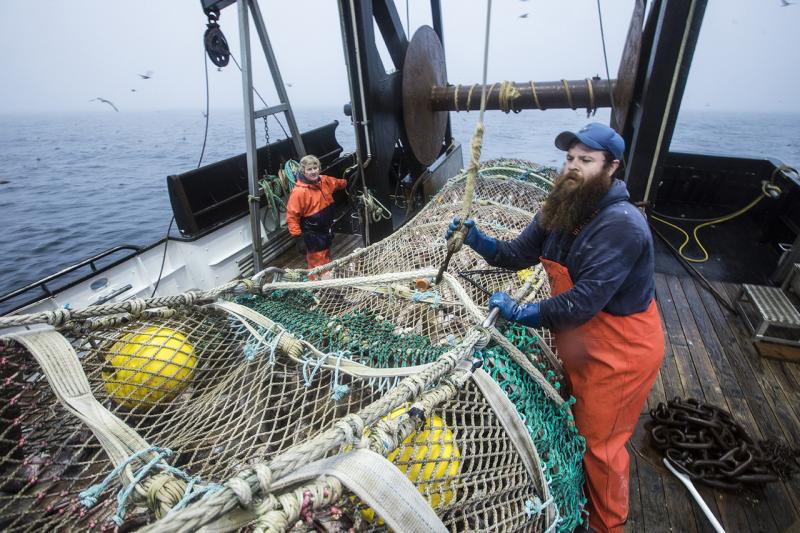With help from rebounding West Coast rockfish, Giuseppe “Joe” Pennisi has put the fisherman back in San Francisco’s famed Fisherman’s Wharf.
Pennisi is the first fisherman to sell freshly caught fish off his boat at Fisherman’s Wharf in many years. He has reintroduced locals to the flaky white fish that was once a mainstay of West Coast seafood. Most weekends when the fishing is good, crowds form early at the dock next to his boat, the Pioneer, and continue all day. Some wait for hours to buy chilipepper rockfish, rose fish, bocaccio and other deep-water species Pennisi brings up in his nets.
“You can’t help but be excited when you get to the dock and all these people are waiting for their fish,” he said.
The reemerging demand for rockfish reflects what may be the West Coast fisheries comeback of the century. Rapidly rebuilding stocks are reviving opportunities for determined fishermen such as Pennisi and customers of his Pioneer Seafoods. From Washington to California, a fishing fleet that sacrificed heavily while groundfish stocks rebuilt are now beginning to harvest the results.
“It really does seem like we’re turning an important corner,” said Shems Jud, who has long tracked the groundfish fishery for the Environmental Defense Fund. The rebuilding of groundfish represents a rarity among environmental issues. Fishermen, environmental groups, fisheries managers, and others replaced contention and controversy with lasting collaboration.
“People could see a pathway forward that was different,” Jud said.
A New Brand of Fishing
Yet the future of the fishery depends not only on fishermen, but also on consumers making sustainable seafood choices.
Pennisi is happy to tell his customers—and show them—how he fishes. His own innovations in net design let him fish along the sea floor with virtually no bycatch—that is, no inadvertent catch of species he’s not after. He estimates that he keeps only about one-third of the fish that enter his net; younger fish and sensitive species escape back into the ocean. He has also developed “light-touch” trawl gear that barely touches the bottom, reducing contact with the sea floor by about 95 percent.
Pennisi shares videos with his customers of smaller, juvenile fish passing through the large-mesh nets that catch only the bigger fish. He likens it to inviting his customers aboard the Pioneer. He posts the local marine report on his Facebook page so his customers can see whether it’s good fishing weather or not. When the catch comes in, he shares videos of his crew sorting and preparing the day’s fish for sale.
“People want to see where their fish comes from, and I am happy to show them,” Pennisi says. “People should have confidence in knowing that when we’re out there fishing, we’re doing it in a way we’re very proud of.”
Pennisi’s success reflects the resurgence of West Coast rockfish, part of a broader category known as “groundfish.” This group also includes larger commercial fisheries for voluminous species such as hake, also known as Pacific whiting. Consumers may encounter rockfish listed on menus (incorrectly) as “red snapper.” It is actually one of dozens of stocks from Pacific Ocean perch to chilipepper rockfish that fishermen hope will bounce back to prominence in West Coast fish markets.

A black and yellow rockfish, also known as groundfish, off the West Coast. Photo by California Department of Fish and Wildlife
Too Much Fishing, Too Fast
During the 1980s, the West Coast groundfish fishery was a national model in building a valuable fishery quickly. Government financing helped fishermen build larger boats and buy expensive gear, and the fleet fished as fast and as much as they could. Lots of unwanted bycatch got tossed back into the ocean, dead.
The fleet grew too big, too fast, with almost 500 vessels at a time when the catch could support only half that. Oregon fisherman Dave Smith remembers spending 300 days a year on the ocean, “and that was just too much.”
“All of a sudden we realized we were overfishing them,” he said. “It was a lack of knowledge of the limitations of the resource. I’m not blaming anyone, it was just ignorance of how much was there.”
Rockfish dropped precipitously to the point that bocaccio was under consideration for listing under the Endangered Species Act. By the late 1990s, the catch was dropping sharply. Processing plants began standing idle; fishing vessels went up for sale at bargain prices, storefronts closed in port communities.
Many fishermen who could not hang on financially gave up fishing altogether.
The renewed health and sustainability of the fishery reemerged only through the determination, collaboration, and sacrifice of fishermen such as Pennisi. Their willingness to demonstrate that a different brand of fishing could work helped turn the fishery around.
“More than ever you need to be able to catch the right fish,” he said. “There are so many fish out there now, it’s easy to catch the wrong ones. We need to show people we know how to do it right.”


